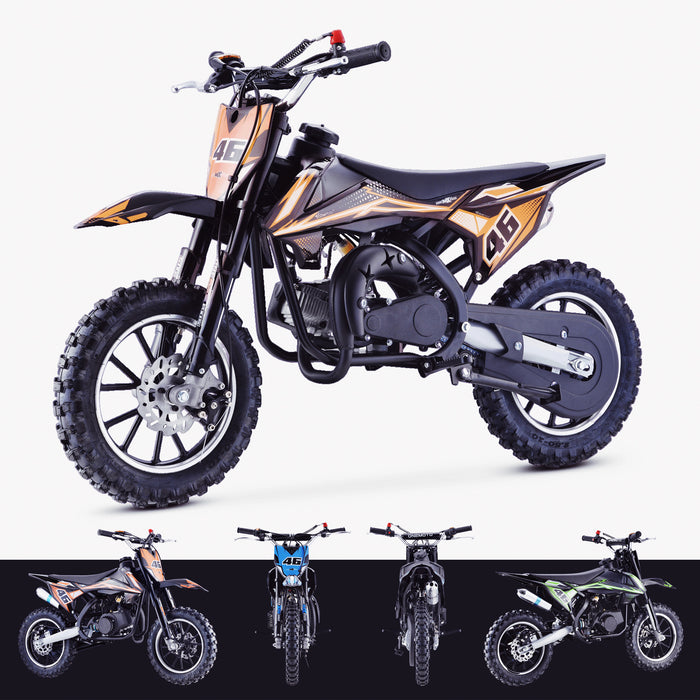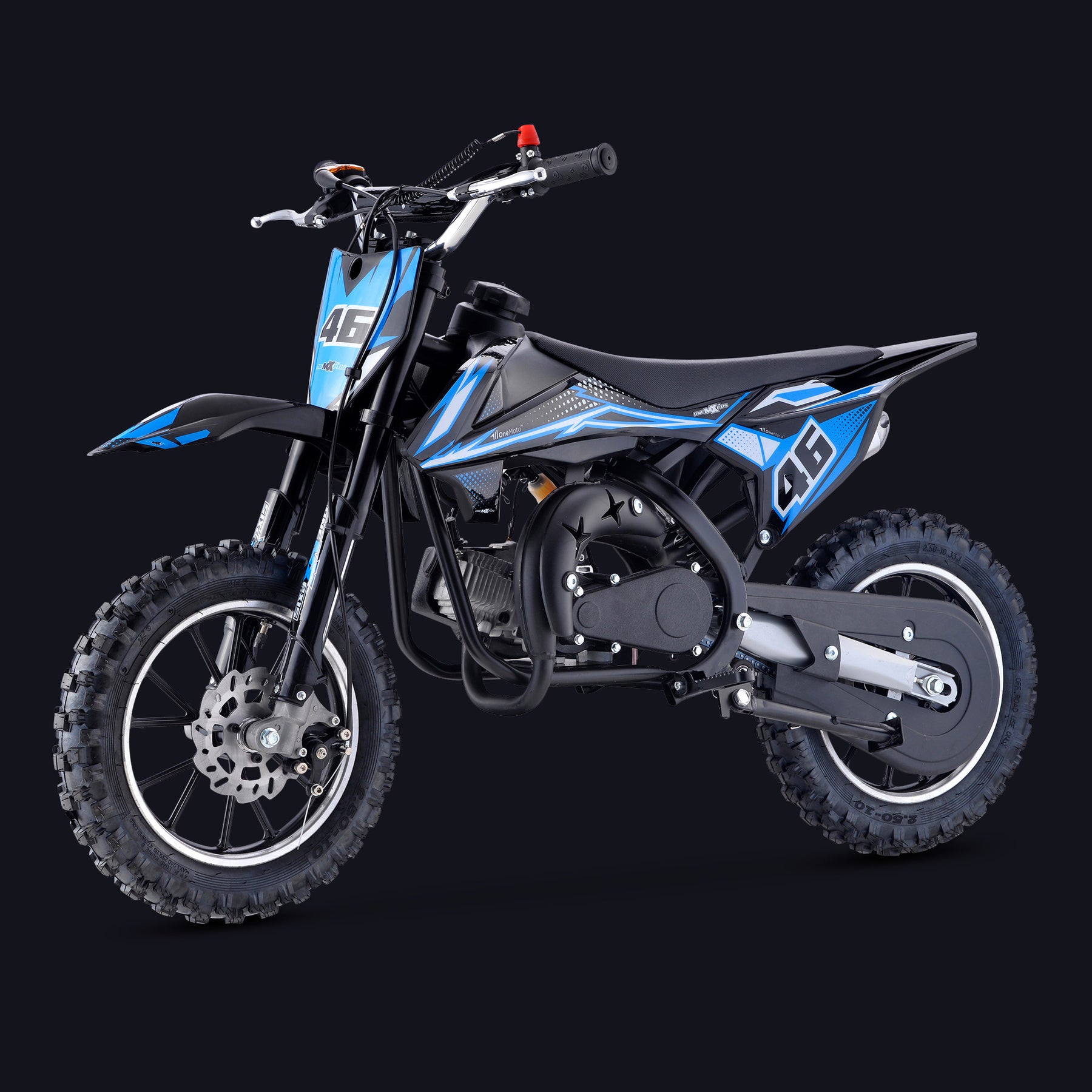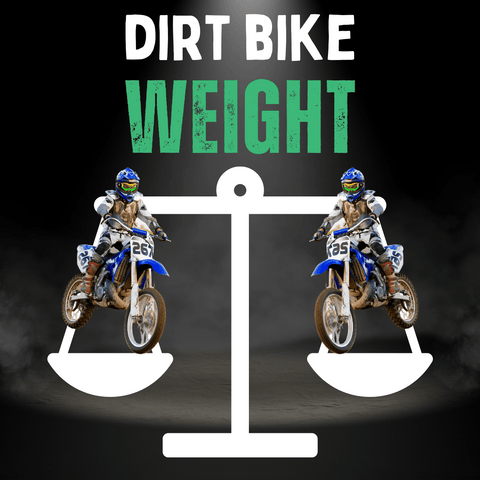
When it comes to the thrilling world of dirt biking, there's an age-old debate echoing through muddy trails and racing circuits alike.
Should you go for a 2-stroke or a 4-stroke dirt bike?
If you find yourself on the fence, don't fret!
This guide will clear the dust and help you make an informed decision based on your riding style, terrain preferences, and much more.
Which One Fits Your Ride?
2 Stroke vs 4 Stroke Dirt Bikes
2-stroke dirt bikes, though not as torquey as 4-strokes, have their merits. They're lightweight, user-friendly, ideal for novices, and generally demand fewer upkeep tasks, benefiting both time and budget.
Understanding the Basics
Dirt bikes, regardless of their type, have engines. And the key distinction between these two heavy hitters?
The strokes, or motions, of the piston. But what does that even mean?
What are Strokes?
In layman's terms, a 'stroke' in an engine is essentially a motion. Imagine an athlete doing lunges; each lunge is akin to a stroke.
Now, whether an engine lunges twice or four times during a cycle determines whether it's a 2-stroke or 4-stroke.
2-Stroke vs 4-Stroke - The Key Motions
- 2-Stroke: It's like a sprinter. Quick. Two motions and they're off!
- 4-Stroke: Think of a methodical dancer. Four deliberate, rhythmic motions.
Related: Why Are Dirt Bikes So Expensive?
Diving Deeper - 2-Stroke Dirt Bikes
Ah, the 2-stroke! The firecracker of dirt bikes. What makes them tick?
The Powerhouse of Speed
They're the hare in the race – faster, albeit a tad more unstable.
Perfect for those looking for that adrenaline rush every time they throttle up.
Simplicity at its Best
Ever heard of the KISS principle? (Keep It Simple, Stupid). That's the 2-stroke for you.
Their designs are straightforward, making them easier to maintain.
Lightness and Agility
Imagine a gymnast. Lightweight, nimble, and agile. That's the 2-stroke for you, especially when navigating challenging terrains.
Fueling the Beast
Here's the kicker: 2-strokes require a cocktail of oil and gas to run[6].
Terrain Compatibility
Planning to tackle technical terrains or keen on enduro riding/racing?
The 2-stroke might just be your trusty steed.
2-Stroke Dirt Bikes Pros and Cons:
-
Pros:
- Quicker power delivery results in faster acceleration.
- Engine mechanisms are simpler leading to easier maintenance.
- Lighter weight provides a unique advantage in agility.
- Unparalleled advantages in technical terrains and enduro racing.
-
Cons:
- Reduced stability due to rapid acceleration can be a disadvantage for some.
- The engine requires a mix of oil and petrol, which might be seen as a disadvantage by some riders.
Related: What Kind of Petrol/Gas Does a Dirt Bike Take?
Unraveling the 4-Stroke Dirt Bikes
And then there's the 4-stroke, the marathon runner of dirt bikes.
Let's uncover its secrets.
Consistent Power and Top Speed
The 4-stroke isn't about abrupt power. It delivers consistent power, ensuring you have a steady ride with a commendable top speed.
Fuel Efficiency and Range
They might be the tortoise in the tale, but they can go the distance with more fuel efficiency and a longer range.
Complexity and Maintenance
They're a bit like high-maintenance pets, thanks to their intricate design.
But, if you're willing to invest the time, they're loyal companions on the track.
The Weight Factor
Bulkier and heavier, the 4-stroke may not be as nimble as the 2-stroke.
But, with great weight comes great stability, especially on open tracks.
Related: How Much Does a Dirt Bike Weigh?
Terrain Compatibility
Got your sights set on open tracks? Or perhaps dual sport riding or competitive track racing?
The 4-stroke won't disappoint.
4-Stroke Dirt Bikes Pros and Cons:
-
Pros:
- Consistent power delivery means a stability advantage on tracks.
- Better fuel combustion efficiency resulting in a longer range.
- Suited for various riding conditions thanks to its versatility.
-
Cons:
- Heavier, which can be a disadvantage in technical terrains.
- Engine mechanisms are complex leading to challenging maintenance tasks.
Related: How Fast Does a 250cc Dirt Bike Go? (ANSWERED)
Making the Choice - Factors to Consider
So, which dirt bike suits you?
Your Riding Style and Purpose
Race or leisure? Your preference can influence the best fit for you.
Terrain Preferences
The type of ground you ride on can make a world of difference in your choice.
Maintenance Willingness
Got the time and patience for maintenance? It can be a decisive factor.
Budget Constraints
Sometimes, it's down to the pennies. Design complexities can affect the price tag.
Related: Petrol or Electric? Which Dirt Bike is Better For You?

Resale Value
When we discuss the differences in resale value, both types of dirt bikes have their unique advantages and disadvantages.
2-Stroke Dirt Bikes:
- Resale Prospects: Typically, they have a slightly lower resale value due to their simpler engine mechanisms and shorter lifespan.
- Maintenance Records: A 2-stroke with comprehensive service records can still be attractive to potential buyers.
4-Stroke Dirt Bikes:
- Resale Prospects: Holding better resale value is an advantage attributed to their durable engine design.
- Maintenance Records: The complexity of their engine mechanisms means that a well-maintained bike can fetch a higher resale value.
Related: Should I Buy a Dirt Bike?
Environmental Impact
Understanding the environmental differences between 2-stroke and 4-stroke is essential.
2-Stroke Dirt Bikes:
- Emissions: Their engine combustion process releases more exhaust emissions, including unburnt oil, which might not meet certain EPA standards.
- Noise: They produce louder noise due to their explosive power delivery, which can impact the environment in noise-sensitive areas.
4-Stroke Dirt Bikes:
- Emissions: More environmentally friendly with sustainable combustion leading to fewer exhaust emissions.
- Noise: Their engine mechanisms produce a quieter noise, which is seen as an advantage in areas with noise restrictions.
While both have environmental impacts, the 4-stroke is marginally kinder to Mother Nature.
Conclusion
In wrapping up, the dynamics of 2-stroke and 4-stroke dirt bikes bring unique offerings to the table.
A 2-stroke might not match the torque prowess of a 4-stroke, yet it's nimble, light, and notably user-friendly, making it a top choice for novices and weekend riders.
Its low-maintenance nature further amplifies its appeal, often leading to both time and financial savings.
Conversely, the 4-stroke offers a different set of benefits.
Ultimately, it's not a question of which bike is universally superior, but rather which complements your riding style and needs.
So, are you leaning towards the agile sprinter or the steadfast endurance champion?
Whichever path you tread, ensure the bike aligns perfectly with your ride.
FAQs
Are 2-stroke dirt bikes more environmentally friendly than 4-stroke?
Yes, 2-stroke engines emit more pollutants. In fact, a single 2-stroke engine produces pollution equivalent to 30 to 50 four-stroke engines, making 4-strokes more environmentally friendly.
Which dirt bike is more cost-effective in the long run: 2-stroke or 4-stroke?
2-strokes typically have fewer maintenance costs due to their simpler design and fewer components. However, they run at higher RPMs, leading to faster wear. On the other hand, 4-strokes are generally more durable and last longer, potentially balancing out long-term costs.
Can beginners handle the power delivery of a 4-stroke dirt bike?
Yes, beginners can manage a 4-stroke's power, especially with a 250cc model. For those weighing under 150 pounds, bikes under 250cc are often adequate, while heavier riders might benefit from the suspension in 250cc models.
How often do 2-stroke and 4-stroke dirt bikes require servicing?
For 4-stroke dirt bikes, it's advised to change the engine oil every 5 hours and replace the oil filter every 10 hours. In contrast, 2-stroke bikes require a gearbox oil change every 6 hours. Additionally, considering the forks' wear and tear, it's recommended to change the fork oil after 25 hours of use.
Get in Touch 🚀
Hey there, savvy shopper! Loved our article on “2 Stroke vs 4 Stroke Dirt Bike: Which One Fits Your Ride?"
Got the itch to dive into more wheely-awesome info?
Whether you're a parent or a grandparent, we're here for all your kids ride-on toy questions! 🚗💨
Feeling click-happy?
Jump straight into our wonderland at RiiRoo.com. Or, if you're more the chatty type, give our Live Chat a whirl and let's talk toys!










Share:
How To Ride A Dirt Bike With A Clutch (FOR BEGINNERS)
10 Reasons Why Your Dirt Bike Won't Start & How to Fix